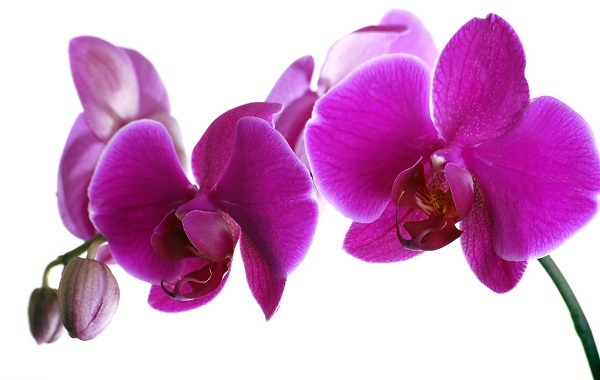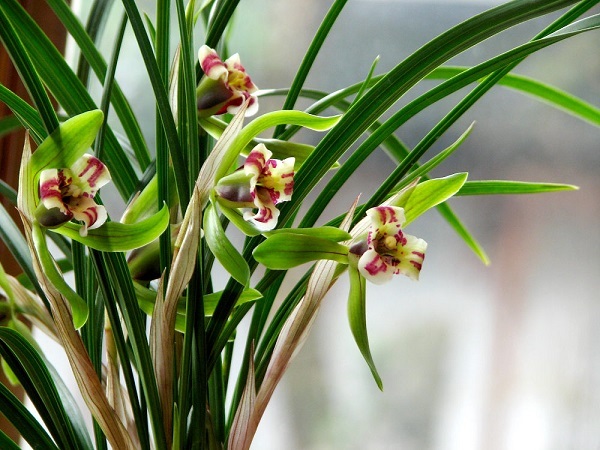What is the reason why orchids do not bloom?

1, seed seedlings and tissue culture seedlings even if cultivated for many years is not necessarily flowering, just like other plants, such as fruit trees to a certain age to bear fruit, orchids also to a certain age to blossom and bear fruit.
2, the species differences between the orchid species are different, different climatic conditions around the orchid is difficult to bloom is also a common phenomenon, take Chunlan, some areas are more difficult to bloom, or can bloom less. For example, in Hainan or the south of Guangdong, where the temperature of the four seasons is relatively high compared with other parts of the country, there are also phenomena that do not bloom or cannot bloom normally due to the large latitude difference between the north and south.
3. The physiological growth of orchids is disrupted due to various reasons, and new leaf buds burst out during the formation period of flower buds. In this case, orchids have no more nutrients to maintain the normal differentiation of flower buds, resulting in flower buds stopping growth and failing to bloom.
4. Improper cultivation methods may also lead to orchids not flowering, excessive nitrogen content in orchids, and insufficient phosphorus and potassium fertilizers, resulting in excess nutrient growth and inhibition of reproductive growth. Just like the fruit trees planted by farmers in front of and behind their houses, orchids grow branches and do not bear fruit because the soil is too fertile and garbage and livestock manure are often dumped.
[Reasons why orchids do not bloom] What if orchids do not bloom
There are many reasons why orchids don't bloom. Lanyou needs to investigate and analyze. A normal adult orchid, as long as it reaches more than two or three seedlings, can bloom under normal circumstances if cultivated properly, but the actual orchid is not very easy to raise. Orchids in the breeding process, a little improper handling will easily rot roots, rotten stems or orchids don't bloom. Generally, if the orchid stems and buds rot, do not deal with it, then the roots will rot, the leaves will turn yellow, and finally the orchid will definitely not bloom.
5 reasons why orchids do not bloom 1. Orchid plants are still small and do not have flowers
Orchid plants are small and lack reproductive genes. Some young seedlings that have not yet formed pseudobulbs need two years of vegetative growth to form pseudobulbs, and then sprout new shoots two or three times. When the branches are three generations in the same house, they may bloom.
2. Orchid ramets destroy fertility genes
Separate plant scattered planting will destroy the reproductive gene transmission habit of orchid generation, so orchid should be planted in groups, with few leaves, less accumulation of organic matter ash, and no active reproductive gene. Generally, it is difficult to flower without three generations of false bulbs.
3. Orchids do not bloom: the environment is not adapted
Dry and wet is not appropriate, spring and summer and autumn are the vegetative growth period of orchids (but to avoid plum rain and avoid heavy rain attacks), if the autumn is a thousand, it will flush the vegetative growth. Winter is its dormancy period, should be dry, such as too wet on the easy to make the pot soil ice expansion, squeeze the roots, affect the spring and summer of the next year to shoot new shoots, but also affect its normal reproductive growth.
Orchids do not bloom: too little light
There is too little light, and the accumulation of organic matter is limited to meet the needs of reproductive growth. Although orchid is fond of shade flowers, but does not mean without time, it only avoid direct light and long light. Diffuse and diffuse light (semi-shade) is required. Often grow in the shade of the plant, green leaves luxuriant, but more difficult, less flowering; and longer than the south and summer half-shade plants although the leaves slightly yellow green shout, but more flowers, and beautiful and fragrant.
5. Orchids do not bloom themselves
Orchids cannot bloom for their own special reasons, or there are very few orchids that do not like to bloom. This phenomenon has appeared in various orchid species, I have also encountered: 04 years of local downhill a plant bud orchid, in this garden has been cultivated for six or seven years, also developed to more than ten pots, has never seen flowers until now, this is probably the plant (orchid) infertility phenomenon!
How do orchids not bloom? 1. Cultivate strong seedlings
Generally, spring orchids for flower appreciation cannot be disassembled into single seedlings for reproduction when they are divided into pots. It is best to have three seedlings connected to the next pot, so that strong seedlings can be bred.
2, enhance the light
Light is the main factor affecting orchid growth and flowering. Plants rely on sunlight for photosynthesis and produce nutrients indispensable for their growth. Spring orchid growth and flower formation require sufficient light. Sunlight can help orchid leaves carry out photosynthesis, create "food", and support orchid seedlings to grow and bloom. In addition to summer and early autumn, spring orchids cannot be exposed to direct sunlight, and the rest of the season can not only make the orchid seedlings healthy and strong, but also strengthen the bulbs and promote the propagation of buds. Blooming orchids tend to bud more easily.
3. Master watering
Water is one of the material bases for plant growth, but there should be a limit to the amount of watering. Watering can not be fixed time, but should seize the opportunity. Dry is watered, watered thoroughly, orchid basin dry will be watered, this is the basic principle of watering. When watering, it should be noted that the temperature of the water should be as close as possible to the temperature in the orchid basin in the orchid cultivation place. Summer and early autumn can be watered in the morning and evening, and winter at noon, the purpose is to reduce the temperature difference between the water and the orchid pot. Orchids should generally be watered during the growth period, and watering should be strictly controlled before flower buds are formed.
What is the reason for the flowers not to bloom?
To grow better carter orchids, timely pruning is necessary. When does Carter's Orchid bloom? What are the reasons for not flowering:
When does the flower bloom:
Catalan flowers generally in spring and autumn, flowering 1 - 2 times a year, flower period is generally 3 - 4 weeks.
A horticultural hybrid of the genus Catalan, it is one of the most famous orchids in the world. Pseudobulb was clavate or cylindrical, the top has 1 ~3 leaves; thick and hard leaves, concave midvein; flowers single or several, attached to the top of the pseudobulb, flowers large and beautiful, bright and rich color.
Originated in tropical America, it is the national flower of Brazil, Argentina, Colombia and other countries. There are thousands of varieties. Colors are white, yellow, green, red and purple. Plant division, tissue culture or aseptic seeding for propagation. Sexual preference for warmth, humidity and plenty of light.
Usually potted with fern roots, moss, bark pieces, etc. The growing season requires higher air humidity, proper fertilization and ventilation.
What is the reason why Carter orchids do not bloom:
Generally, it takes 4 to 6 years for Catalan to mature from test-tube seedlings to flowering. If, during growth, the plant is not mature and frequently divided in order to achieve the production quantity, flowering is impossible or rare because the plant does not have enough time to mature.
Therefore, in the cultivation process, this work should be carried out only if the plants have grown to the whole pot surface or if the substrate, such as water moss, has rotted and has to be replaced. As mentioned above, frequent ramets affect flowering.
Light is the most important factor affecting the plant health and flowering of Catalan. Insufficient light will delay flowering or low flowering rate. The key to how to care for Catalan orchids is that Catalan needs more light. In addition to noon, the sun can shine directly on the plants. It can be placed on the east and shaded south windowsill, and it can also be placed on the west windowsill.
If it is cultivated in greenhouse, it should be shaded to 50%~70% of full sunlight. Leaves should be medium-green and pseudobulbs erect if well lit, but some varieties do not need much sunlight, such as dark vermilion flowers and mini florets that bloom in winter.
Carter orchids are really beautiful and live up to their reputation.
- Prev

What if orchids don't blossom?
The main results are as follows: 1. Light is the main factor to promote the bud formation of orchid plants. Flower leaves are soft and moderate green, indicating normal light; dark green and soft leaves, indicating the need for more light; yellowish leaves, indicating less light. 2. If the temperature promotes the flowering of orchids, it is necessary to make the temperature difference between day and night about 10 ℃.
- Next

The cultivation method of Happiness Tree
The cultivation method of Happiness Tree
Related
- Fuxing push coffee new agricultural production and marketing class: lack of small-scale processing plants
- Jujube rice field leisure farm deep ploughing Yilan for five years to create a space for organic food and play
- Nongyu Farm-A trial of organic papaya for brave women with advanced technology
- Four points for attention in the prevention and control of diseases and insect pests of edible fungi
- How to add nutrient solution to Edible Fungi
- Is there any good way to control edible fungus mites?
- Open Inoculation Technology of Edible Fungi
- Is there any clever way to use fertilizer for edible fungus in winter?
- What agents are used to kill the pathogens of edible fungi in the mushroom shed?
- Rapid drying of Edible Fungi

